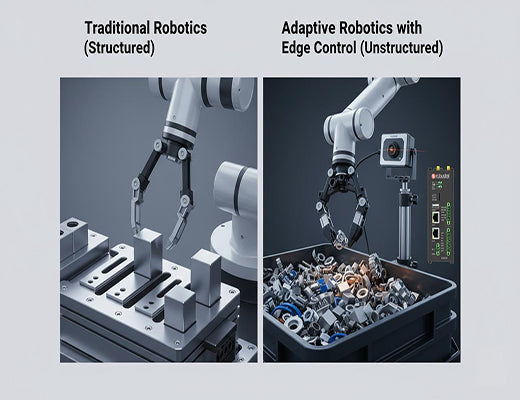
Edge Control for Robotic Arms: Enabling Adaptive Grasping and Sorting
|
|
Time to read 4 min
|
|
Time to read 4 min
This guide explains how edge control is unlocking the next frontier of robotics by enabling adaptive grasping and sorting. Traditional robotic arms are "blind," limited to picking up perfectly placed, identical objects. By pairing a 3D vision system with a powerful edge gateway, edge control gives the robot "eyes" and a "brain" to perceive, identify, and handle randomly oriented or mixed objects in real-time. This is the key technology that makes complex applications like robotic bin picking a practical reality.
Traditional robotic arm control is based on pre-programmed paths, which fails in any unstructured environment.
Edge control provides the "sense-decide-act" loop needed for a robot to adapt to its environment in real-time.
The architecture involves a 3D camera to "sense," a powerful edge gateway with an NPU (like the EG5120) to "decide," and the robot controller to "act."
The edge gateway's ability to process complex 3D vision data locally, with millisecond latency, is the critical enabler for high-speed, adaptive robotic applications.
I was watching a state-of-the-art robotic arm on a production line. It was a marvel of speed and precision, flawlessly picking up a part from a fixture, placing it into a machine, and repeating the cycle every 3 seconds. Then, a single part was accidentally jostled out of position by a few millimeters. The entire line stopped. The robot, blind to the change, couldn't adapt. An operator had to manually reset the part.
This is the fundamental limitation of traditional robotics. They are masters of repetition, but they are slaves to a structured world. What if that robot could see the part's new position and adapt its grasp on the fly?
Let's be clear: it can. The technology that gives a robot this perception and real-time intelligence is edge control.

A standard industrial robot follows a pre-programmed script of coordinates. It assumes that the target object will always be in the exact same place, in the exact same orientation. This works perfectly for highly structured, repetitive tasks. It completely fails in "unstructured" environments, which are common in logistics and manufacturing, such as:
Solving these problems requires giving the robot a sense of sight and a brain to interpret what it sees. This is the core task of edge control for robotics.
The 'aha!' moment for any robotics integrator is seeing how an edge gateway acts as the "vision brain" that works in partnership with the robot's own controller.
This is a classic and high-value robotics challenge, solved with edge control.
This entire "sense-decide-act" loop must happen in a fraction of a second. The low-latency, high-performance processing of the edge gateway is what makes it possible.

Edge control is fundamentally changing the definition of industrial robotics. It is moving the technology beyond simple, repetitive tasks and into a new realm of perception, adaptation, and intelligence. By using a powerful edge gateway as the "vision brain," integrators can now solve previously "unsolvable" automation challenges like bin picking and mixed-part sorting. This is the key to building more flexible, more intelligent, and more valuable robotic systems.
Further Reading:
What is Edge Control? The Future of Real-Time Industrial AutomationEdge Control for CNC Machining: A Guide to Real-Time Optimization
From Selling Machines to Selling Uptime: How Edge Control Enables Servitization for OEMs
A1: Robot controllers are highly specialized real-time systems designed for one primary task: fast and precise motion control (kinematics). They are typically not designed with the powerful, general-purpose CPUs/NPUs or the open software environments (like Linux + Docker) needed to run complex, modern AI vision applications. The edge gateway provides this specialized computing resource.
A2: A point cloud is the 3D data format generated by a 3D camera or LiDAR sensor. Instead of a flat 2D image, it's a collection of thousands or millions of individual points, each with its own X, Y, and Z coordinate in space. Processing this complex data in real-time requires significant computational power, which is why a powerful edge device is necessary.
A3: In robotics, "pose" refers to an object's position (its X, Y, Z location) and its orientation (its roll, pitch, yaw rotation) in 3D space. Pose estimation is the process where an AI vision system determines this precise position and orientation, which is essential for telling the robot exactly where and how to grasp the object.